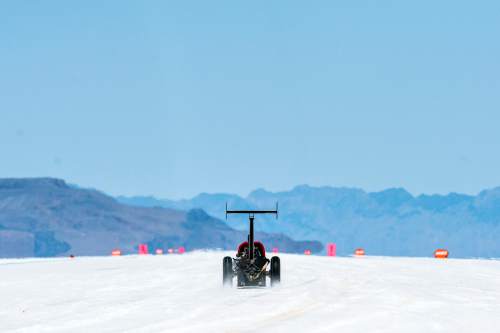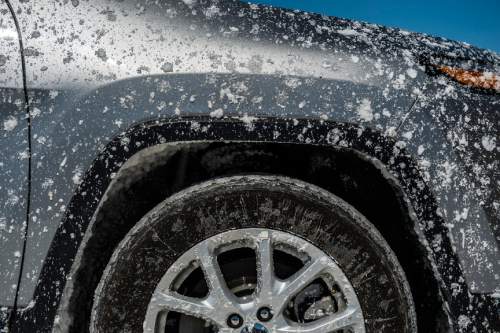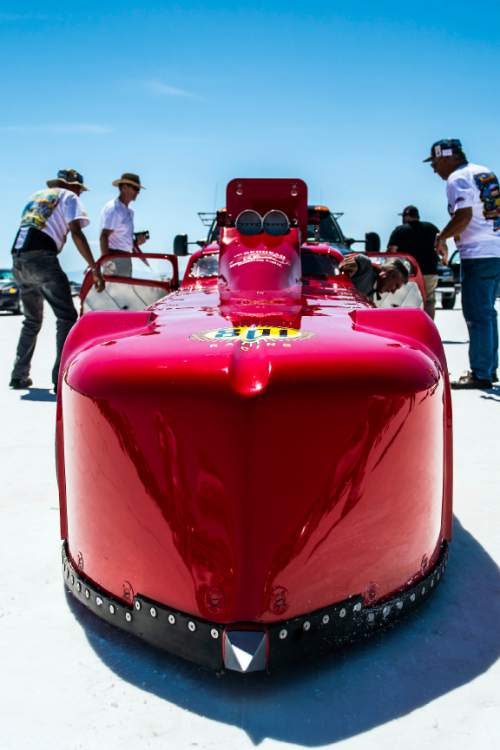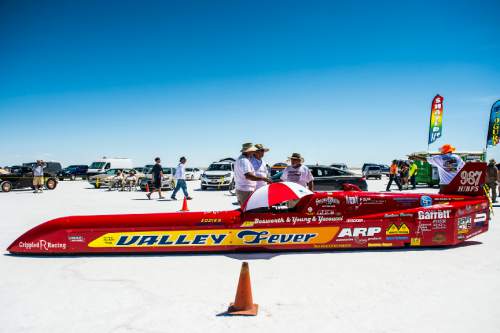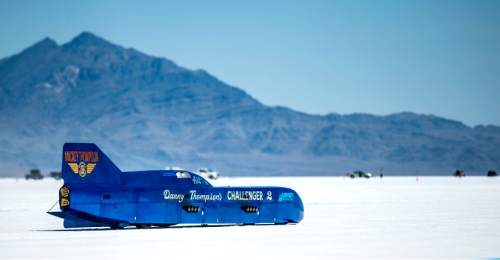This is an archived article that was published on sltrib.com in 2016, and information in the article may be outdated. It is provided only for personal research purposes and may not be reprinted.
Bonneville Salt Flats • Larry Volk knows salt.
The long-time land-speed racer first stepped foot on the Bonneville Salt Flats as a high school senior in 1958. He was a founding member of the Utah Salt Flats Racing Association and was president for some 30 years. He's owned cars capable of surpassing 200 miles per hour.
And so unlike some of the perhaps less-experienced racers descending upon the salt flats for Speed Week this weekend, Volk is not convinced that this year's salt is proof the Salt Flats have begun to recover from what appears to be a 30-year trend of decline.
"The salt you see right now, it's not good salt. It's soft, and you can break it up," he said. "We call it popcorn, a little bit of popcorn on top of it. When you clear off the popcorn and see a blueish tinge, that's good stuff. You want to look for pressure ridges."
The salt on this year's courses isn't blue, and doesn't have pressure ridges. The crust is flakey and assumes the approximate consistency of table salt beneath the racers' feet. The tires of the various race cars and motor bikes kick up pale clouds in their wake.
So despite the resumption of racing activities on the Bonneville Salt Flats after two years of cancellations, the racing community will continue to pressure the Bureau of Land Management to take action to save the famous salt flats.
That could still take some time, according to the BLM. Matt Preston, the new field manager for the Salt Lake Field Office, which oversees the Bonneville Salt Flats, said he has committed to review the sizable restoration proposal drafted by the Save the Salt coalition.
There's no guarantee the BLM will adopt any of their suggests, said Preston, who assumed his new position just two months ago. As field manager, he said, he's promised to at least get a formal response to the racing community.
"The best thing I can do right now to create relationships with these folks is to be really responsive and transparent," he said.
In the interest of pursuing a science-based management plan, Preston said he is primarily waiting for the results of a University of Utah study of the salt flats, which kicked off earlier this year but will begin in earnest in September, when researchers begin collecting sediment cores to study the salt crust.
Preston said he felt that the racers he met on Saturday, the first day of Speed Week, were receptive to his message. But some participants in Saturday's event said they weren't inclined to trust the BLM.
"Anybody can make a promise, but you have to keep those promises," said Louise Noeth, an outspoken proponent of the Save the Salt initiative. "But the BLM hasn't kept many of their promises to us."
After an unsuccessful attempt to negotiate a resolution with the BLM, Save the Salt has taken its battle to Washington, D.C. Dennis Sullivan, president of the Utah Salt Flats Racing Association, said the organization currently has a bill in the works in the office of sponsoring Congressman Chris Stewart.
That bill, which would require the BLM to establish a management plan and restore the salt to conditions not seen since 1960 by 2026, is expected to be introduced soon after Congress resumes this fall.
In the meanwhile, auto enthusiasts are off to the races once again. But the salt is rough, and even elite drivers are taking their initial runs slower than they would as they judge the safety of the course.
That course, Volk said, will probably have to be reconfigured at least four times this week, because the thin salt is already breaking up beneath the race cars' wheels.
Twitter: @EmaPen




